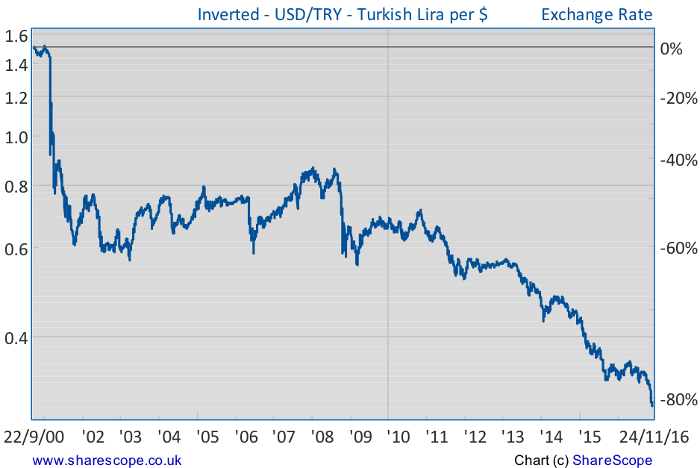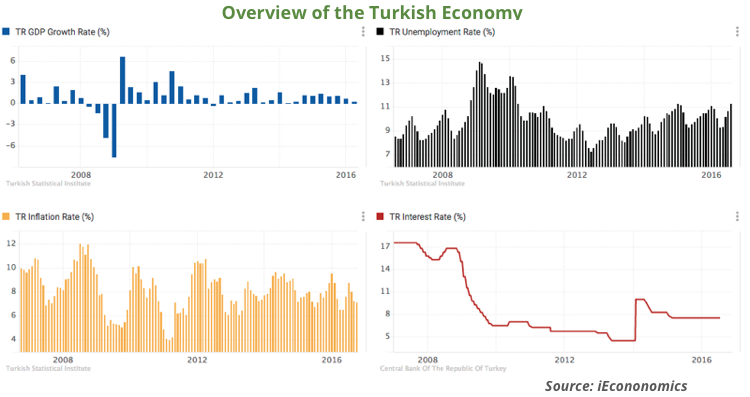Turkey is heading towards chaos

While the global euphoria ignited by Donald Trump persists, there are parts of the world where sentiment is a little weaker. Trump will certainly help central banks to adjust policy and boost the domestic economy, but it will bring a lot of trouble to emerging markets. When I say trouble, I’m not thinking about Trump’s extreme convictions regarding globalisation and protectionism; I’m just referring to the natural consequences stemming from a fiscal boost and faster monetary policy stabilisation in the U.S. The first collateral damage was felt in Mexico. Turkey will be next…
A few months ago, in my article Turkexit is now a reality, I wrote the following:
The CBT has been following an easing policy of cutting rates while inflation is above the 5% target. I really doubt the CBT will be able to maintain its trend of cutting rates without accelerating the depreciation of the lira. I believe that the current low yields observed elsewhere are helping Turkey to retain some of its attractions. But as soon as ratings agencies start cutting Turkey’s rating, the EU-Turkey relationship deteriorates, and/or there is any sign the US may raise rates, the lira will stumble. Because of these considerations, I believe that there is a good fundamental reason to keep a long position in USD/TRY through spread betting to avoid the current sterling risk at a time when sterling is experiencing significant volatility.
At the time, the lira was trading at 3.0289 per dollar.
On the one hand, Erdogan managed to contain the effects of the failed coup. In the wake of the botched insurrection, people came to the streets to express their support for the President and even converted dollars into lira. But four months later, the political and economic scenario has deteriorated again, and it now takes lira 3.4490 to buy one dollar. The dollar has risen 13.9% against the lira, or put another way, the lira has declined 12.2% against the dollar.
The Central Bank of the Republic of Turkey (CBRT) manages three key interest rates, in a similar fashion to the ECB. It establishes a key repo rate and then additionally sets a lending rate (above the repo rate) and a borrowing rate (below the repo rate) to form a corridor system for the repo rate.
At the end of 2013, the repo rate was held at 4.5%, while the other two were defined at 7.75% (lending) and 3.50% (borrowing). At the beginning of 2014, the CBRT hiked all three rates: the repo to 10%, the lending to 12.00% and the borrowing to 7.5%. But, since mid 2014, the CBRT has been cutting its interest rates, starting with the repo rate and then the lending rate, while keeping its borrowing rate unchanged.
The idea was to shorten the corridor. While the borrowing rate was cut from 8.00% to 7.25%, the repo rate was cut from 10.00% to 7.50% and the lending rate from 12.00% to 8.25%. In fact, the repo rate was last cut to 7.50% in February 2016 and all the later cuts have been to the lending rate. The CBRT was preparing to shorten the corridor to 7.25% – 7.75% (with the limits being given by the borrowing and lending rates respectively), but Donald Trump spoiled the party, prompting the CBRT to change tack in October and invert the trend a few days ago as it hiked the lending rate from 8.25% to 8.50%.
An expected inversion in interest rate policy
President Erdogan has been trying to influence the CBRT, claiming interest rates were too high. The CBRT has responded with rate cuts, which have been possible until recently mainly due to the huge delay in interest rate hikes by the FED, the massive asset purchase programmes deployed by the ECB and the political stability in Turkey. But then came the coup in July and Trump in November, which sent the lira into a downward spiral, falling 16% against the dollar and 13% against the euro YTD.
The geo-political and economic situation isn’t favourable in Turkey and we may well see a currency crisis in the near future. There are six main points that are weighing very negatively on the Turkish economy right now:
1) Political instability – While the coup failed to change the government and has been contained by Erdogan, it nevertheless had consequences for the country. A failed coup engenders political instability, which deters foreign investment. At the same time, although capital outflows were contained in July, they have increased significantly of late. While economic and financial conditions may be the main reason for such outflows, the shadow of the failed coup exacerbates them.
2) Tense relations with the EU – Relations with the EU have been deteriorating, thus slashing the chances of Turkey becoming an EU member state. At a time of economic disintegration, that may not come as a significant problem. But given the fact the EU is Turkey’s main trading partner, these tense relations play badly for the Turkish side.
3) Declining interest rate differentials – A mix of expected interest rate hikes in the U.S. and progressive cuts in the lending rate by the CBRT help to shorten interest rate differentials. As these rate differentials decrease, the lira becomes less attractive. If the FED starts hiking rates faster than expected, this will accelerate the downfall of the lira, as the country would experience massive capital outflows.
Turkey currently has an unemployment rate of 11.3%, up from 7.3% in 2012.
4) Weak exchange rate transmission channel – A weaker currency means more exports and fewer imports, which should translate into higher output. But, unfortunately, the Turkish economy depends largely on domestic demand. Although this doesn’t mean that the weaker lira isn’t boosting output, it does mean that a weaker currency may not be as significant as it is for the UK, for example.
5) Weak economic conditions – Turkey currently has an unemployment rate of 11.3%, up from 7.3% in 2012. GDP has not been growing above 2.0% since the second quarter of 2013 and the rate of growth has declined during the last three quarters. Meanwhile, inflation was last recorded at 7.2% (much above the 4% target of the central bank).
6) Rising terrorism – The increase in terrorism is keeping tourists away from the country.
The above conditions lead me to believe that Turkey will face some tough decisions regarding monetary policy. The CBRT won’t be able to keep its key rate at the current level because the lira will continue to decline, eventually at an accelerated rate, as inflation will start to show up. The patriotism that led many Turks to exchange dollar deposits for lira deposits will fade away as households see their purchasing power vanish. By that time, the CBRT will not have any other option than to hike rates. Just to put everything in perspective, I should mention the fact that the average repo rate between 1990 and 2016 has been 59%, with a record high of 500% in March 1994. There’s no reason to believe that, at 7.5%, the repo rate is already high: historically, there is a lot of margin for hikes. But any rate hikes will prove fatal and will lead the economy towards recession. With all this in mind, I maintain my long position in USD/TRY and a bearish view on the Turkish economy.


Comments (0)